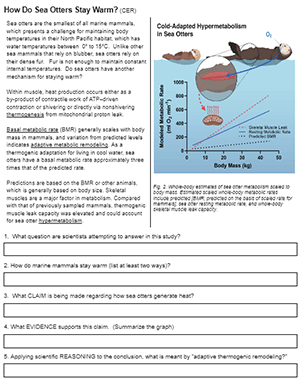
Sea otters live in extremely cold waters of a North Pacific Habitat. They do not have blubber, like many other aquatic mammals. How do they stay warm?
In this worksheet, students examine research that explores how sea otters use a unique method of staying warm: adaptive metabolic remodeling. After reading a short passage describing sea otters and their habitat, students analyze a graph. The data and information is based on a Science Journal article.
Adaptive metabolic remodeling is a process by which cells or tissues alter their metabolic pathways to adapt to changing physiological or pathological conditions. This process involves a shift in the utilization of different fuel sources and is involved in the regulation of essential cellular functions.
The graph explores a BMR, basal metabolic rate, in otters and compares it to a predicted BMR in other mammals. Another line shows proton leak in sea otter muscles. There is a short reading section that describes BMR and how sea otters survive in cold water.

Abstract: The sea otter’s unusually thick fur helps, they are also internally warmed by thermogenic leak from skeletal muscle, a process that elevates their metabolic rate three times above that expected for their size. This mechanism is present even in infants with immature muscles, providing these animals with internal warmth from birth.
A graph illustrates hypermetabolism, a condition where the mitochondria in the muscles leak protons as a method of keeping warm. Students then answer several questions related to the reading and follow up with a CLAIM – EVIDENCE – REASONING (CER).
This is a short exercise I use with a broader unit on animal anatomy and homeostasis. I usually do this unit at the end of the first semester and it includes a survey of animals, a dissection, and various readings and case studies. How much is covered depends on how much time I have left in the semester. I find this unit to be one that can keep them engaged despite the distraction of the holiday season.

